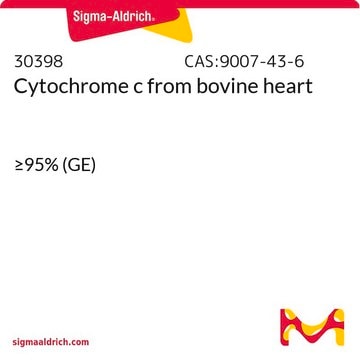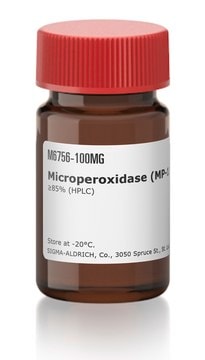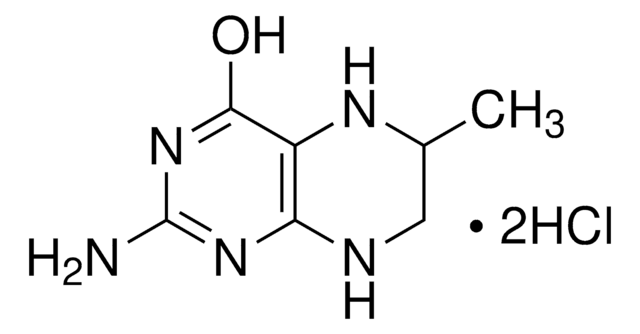C2037
Cytochrome c from bovine heart
≥95% based on Mol. Wt. 12,327 basis
Sign Into View Organizational & Contract Pricing
All Photos(6)
About This Item
Recommended Products
biological source
bovine heart
Assay
≥95% based on Mol. Wt. 12,327 basis
form
powder or crystals
mol wt
12327 Da
technique(s)
cell based assay: suitable
suitability
suitable for molecular biology
UniProt accession no.
application(s)
cell analysis
storage temp.
−20°C
Gene Information
cow ... CYC1(512500)
Looking for similar products? Visit Product Comparison Guide
General description
Cytochrome C is a heme protein. It is localized between the inner and outer mitochondrial membranes.
Application
Cytochrome c from bovine heart has been used:
- for cytochrome oxidase staining using the mice brain tissue
- as a component of control mixture to evaluate the accuracy of tandem mass spectra in identifying peptides
- to study its effect on the stability, transport, and retention of biochar colloids (BCs) in saturated porous media under various solution pH and ionic strength (IS) conditions
- as a component of staining solution for the detection of cytochrome oxidase activity in the brain tissue sections of mouse
- as a component in the assay to study its superoxide scavenging efficiency
- as a component of serum-free DMEM media to evaluate non-specific cytochrome C reduction in astrocytes and HT-29 cells
Biochem/physiol Actions
Cytochrome C is a key mediator of oxidative phosphorylation. It mediates the electron transport between complex III and complex IV of the respiratory chain.
Cytochrome c has been identified as an important mediator in apoptotic pathways. The release of mitochondrial cytochrome c into the cytoplasm stimulates apoptosis and is commonly used as an indicator of the apoptotic process in the cell. Investigation on the effect of Paris Saponin I (PS I) on human gastric carcinoma cell growth (SGC7901 cells) have shown an elevated level cytoplasmic cytochrome c. Results are an inhibition of proliferation in SGC7901 cells by inducing mitochondria-dependent apoptosis through cytochrome.
Cytochrome c has been identified as an important mediator in apoptotic pathways. The release of mitochondrial cytochrome c into the cytoplasm stimulates apoptosis and is commonly used as an indicator of the apoptotic process in the cell. Investigation on the effect of Paris Saponin I (PS I) on human gastric carcinoma cell growth (SGC7901 cells) have shown an elevated level cytoplasmic cytochrome c. Results are an inhibition of proliferation in SGC7901 cells by inducing mitochondria-dependent apoptosis through cytochrome.
The ready interconversion of cytochrome c between ferrous and ferric states makes it an efficient biological electron carrier. It plays a vital role in cellular oxidations in both plants and animals. Generally regarded as a universal link in the respiratory chain, it forms the essential electron-bridge between the respirable substrates and oxygen.
Preparation Note
Prepared using TCA.
Other Notes
View more information on cytochrome c and electron transport at www.sigma-aldrich.com/enzymeexplorer.
Storage Class Code
11 - Combustible Solids
WGK
WGK 3
Flash Point(F)
Not applicable
Flash Point(C)
Not applicable
Personal Protective Equipment
dust mask type N95 (US), Eyeshields, Gloves
Certificates of Analysis (COA)
Search for Certificates of Analysis (COA) by entering the products Lot/Batch Number. Lot and Batch Numbers can be found on a product’s label following the words ‘Lot’ or ‘Batch’.
Already Own This Product?
Find documentation for the products that you have recently purchased in the Document Library.
Customers Also Viewed
Rapid microplate assay for superoxide scavenging efficiency
Quick KL, et al.
Journal of Neuroscience Methods, 97(2), 139-144 (2000)
NO Binding to the Proapoptotic Cytochrome c-Cardiolipin Complex
Hough MA, et al.
Vitamins & Hormones, 96, 193-209 (2014)
Wen Yang et al.
Environmental pollution (Barking, Essex : 1987), 246, 855-863 (2019-01-10)
Application of biochar in the field has received considerable attention in recent years, but there is still little known about the fate and transport of biochar colloids (BCs) in the subsurface. Natural organic matter (NOM), which mainly consists of humic
Bcl-2 Family Proteins and the Dysregulation of Programmed Cell Death
Bertino JR
Encyclopedia of Cancer, 179-197 (2002)
Shiyu Xia et al.
Nature, 593(7860), 607-611 (2021-04-23)
As organelles of the innate immune system, inflammasomes activate caspase-1 and other inflammatory caspases that cleave gasdermin D (GSDMD). Caspase-1 also cleaves inactive precursors of the interleukin (IL)-1 family to generate mature cytokines such as IL-1β and IL-18. Cleaved GSDMD
Chromatograms
application for HPLCapplication for HPLCapplication for HPLCOur team of scientists has experience in all areas of research including Life Science, Material Science, Chemical Synthesis, Chromatography, Analytical and many others.
Contact Technical Service







